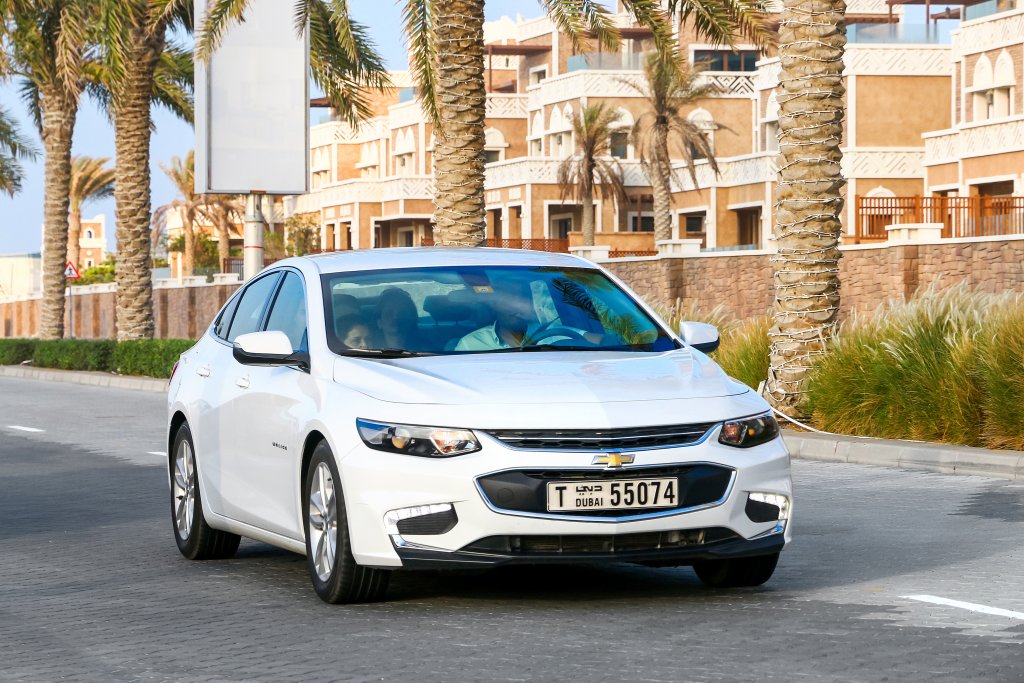The Chevrolet Malibu is a celebrated nameplate in automotive history going back to the 1960s. But today we’re focused on the modern Malibu that returned in 1997 after a 14-year hiatus. In the two decades since, the Malibu has consistently faced off in the mid-size sedan segment, competing against the likes of Toyota’s Camry and the Honda Accord.
For those looking to buy a used Malibu – and if you already have one in the driveway – we’ve put together a ranking of the best and worst model year Malibus between 2001 and 2021. The main factor behind these rankings is the number of Check Engine Lights (CELs) recorded by FIXD devices installed in customer Malibus along with a host of additional objective and subjective data points that we’ll dig into below.
| Best Years | Why? | Worst Years | Why? |
| 2021 |
Top reliability scores, low repair costs |
2007 |
FIXD and owner reliability scores plummet |
| 2017-2019 |
Excellent value, third-gen hybrid efficiency |
2004-2005 |
Issues with first year of sixth generation |
| 2014-2015 |
Successful mid-cycle refresh |
2001-2003 |
Poor performing early models |
| 2012-2013 |
Improvements in reliability, safety, & value |
2009 |
Weak fuel economy, drop in reliability |
| 2010-2011 |
Big step up for FIXD reliability scores |
2016 |
New 9th-gen model teething problems |
| 2008 |
New generation brings well-liked cabin |
2020 |
Two-point decrease in FIXD score |
| 2006 |
Dramatic reliability improvement over prior year |
Chevrolet Malibu Engine Reliability Score, Safety Ratings, MPG, and Value v.s. Maintenance & Repair Costs Year by Year
The first chart below, Malibu Reliability Score, is the main driver of our model year rankings. It is a combination of objective FIXD device data and subjective owner-reported information. Typically the first year of a new generation – like the 2004 – will struggle with reliability as the kinks are worked out, which is reflected in the chart.
From there, we blend in published government safety scores from the National Highway Traffic Safety Administration (NHTSA) and fuel efficiency figures per fueleconomy.gov – both gas and hybrid Malibus.
We also incorporate market values from Kelley Blue Book (KBB) against owner-reported annual maintenance costs. That goes into the ranking decision along with owner survey answers and pertinent safety recalls. Lastly, with details on safety recalls, and pertinent Diagnostic Trouble Codes (DTCs) we can create the final rankings below.
Engine Reliability Score – Over The Years
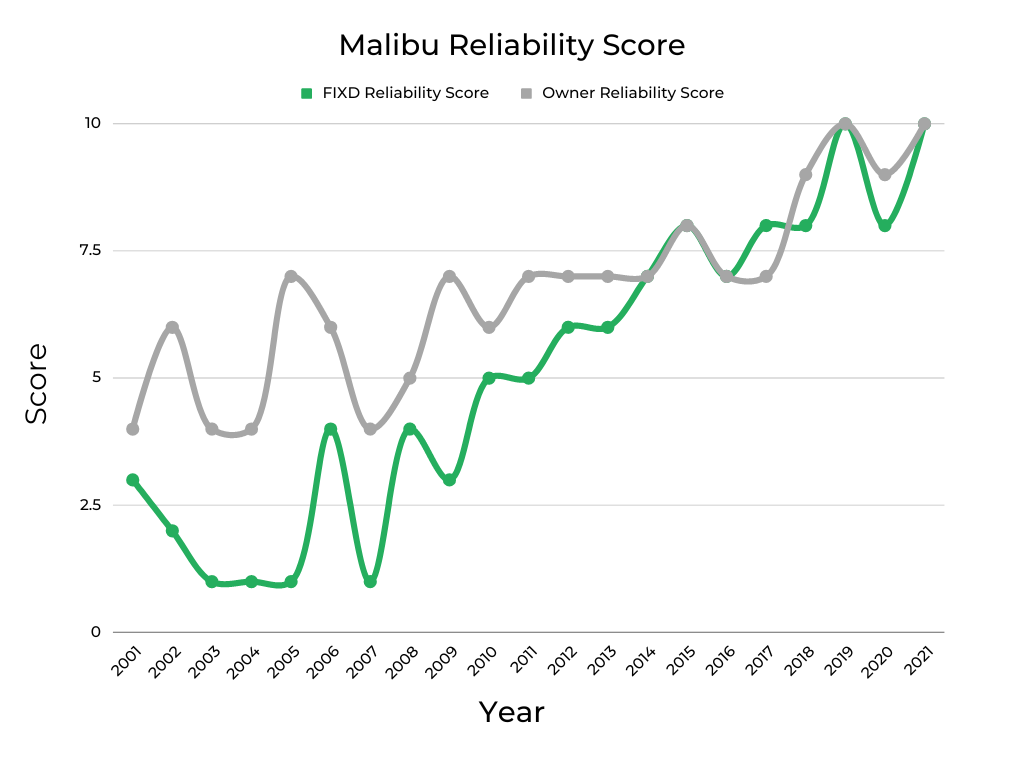
The green line on this Malibu Reliability Score chart is based on the number of CELs thrown by each model year. After tallying them up, we weight this objective score by mileage and convert it into a 1-10 scale where 10 is the best.
By asking Malibu owners, “How reliable would you say your car is?”, we can pull together a subjective reliability score for comparison. This multiple-choice question offers answers from “Just Point A to Point B driving” to “I could take a cross-country trip, no problem.” By converting the answer into a 1-10 scale, we can create the gray line above.
As you can see, the objective and subjective reliability scores mostly move in the same direction. But occasionally, like in 2009, the scores diverge dramatically. We’ll explain this in the relevant sections below but it helps illustrate the importance of analyzing both sets of data.
You can learn more about our reliability scoring process at the bottom of this article and find out what some of the most common CELs to expect from Chevrolet.
NHTSA Safety Score – Over The Years
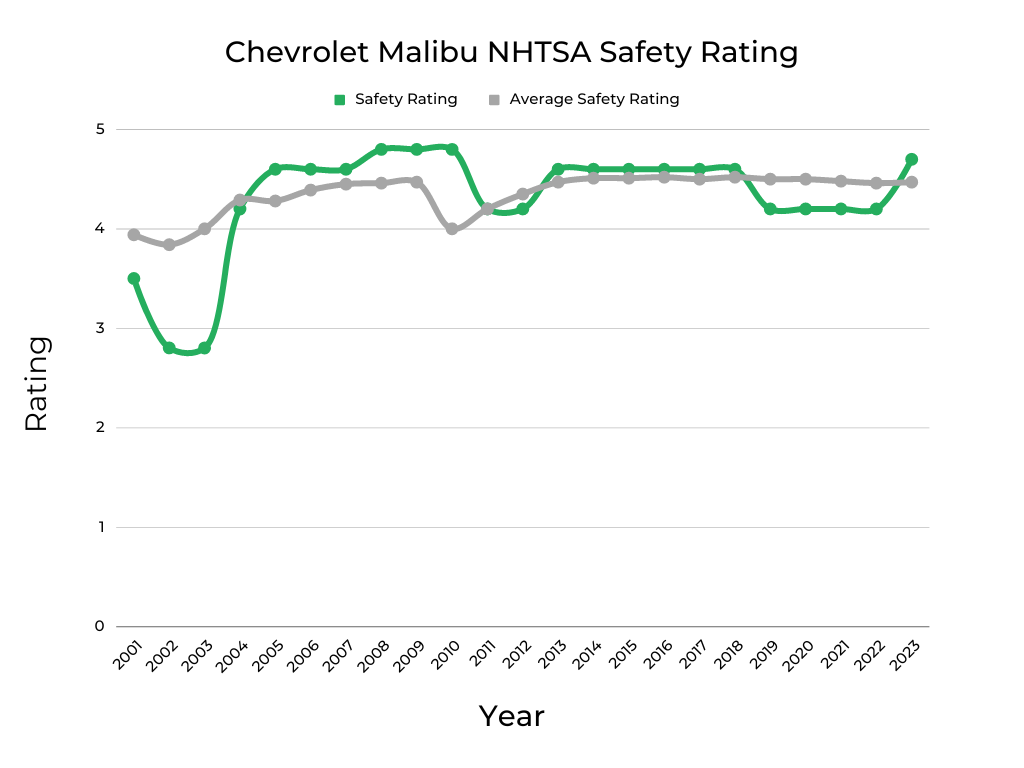
Vehicle safety is an important consideration no matter what you drive but perhaps even more so with a car like the Chevy Malibu as 49% of owners use theirs as a family vehicle. This is why we factor the data on the chart above into our rankings below.
The gray line indicates the average crash test safety rating across the industry per published NHTSA data. The green line is based on data from the same source but only for the Malibu. As you can see, it is generally close to the average though in some years there are dramatic variances as we’ll explain below.
It’s also important to understand how a given model year of the Malibu ranks for safety as it plays a big role in keeping insurance premiums down. If you live in one of the states listed below, we can show you the cheapest vehicles to insure in yours.
| What Used Cars Are the Cheapest To Insure In: |
| Ohio |
| North Carolina |
| Michigan |
| Georgia |
| Texas |
| New York |
| Illinois |
| Pennsylvania |
| California |
MPG – Over The Years
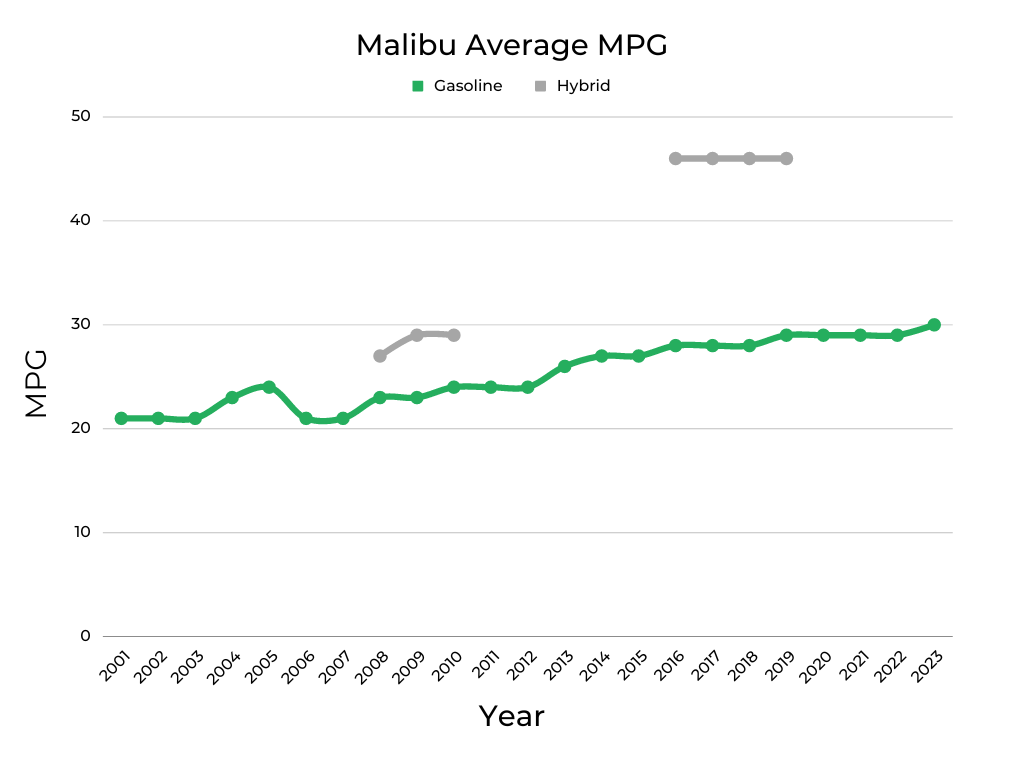
By averaging the combined fuel economy figures – from fueleconomy.gov – across all trims of each model year, we can create the above Malibu MPG chart. As with most vehicles, the Malibu’s fuel economy continually improves year-over-year as powertrains become more efficient and technology improves.
Notable areas include 2013 when the average stepped up two mpg thanks to an all-new Malibu generation with a full powertrain overhaul. And the gray line, representing hybrid model fuel efficiency, is another important consideration in our rankings.
Current Market Value of All Chevrolet Malibu Years & Cost Per Year to Repair and Maintain Each
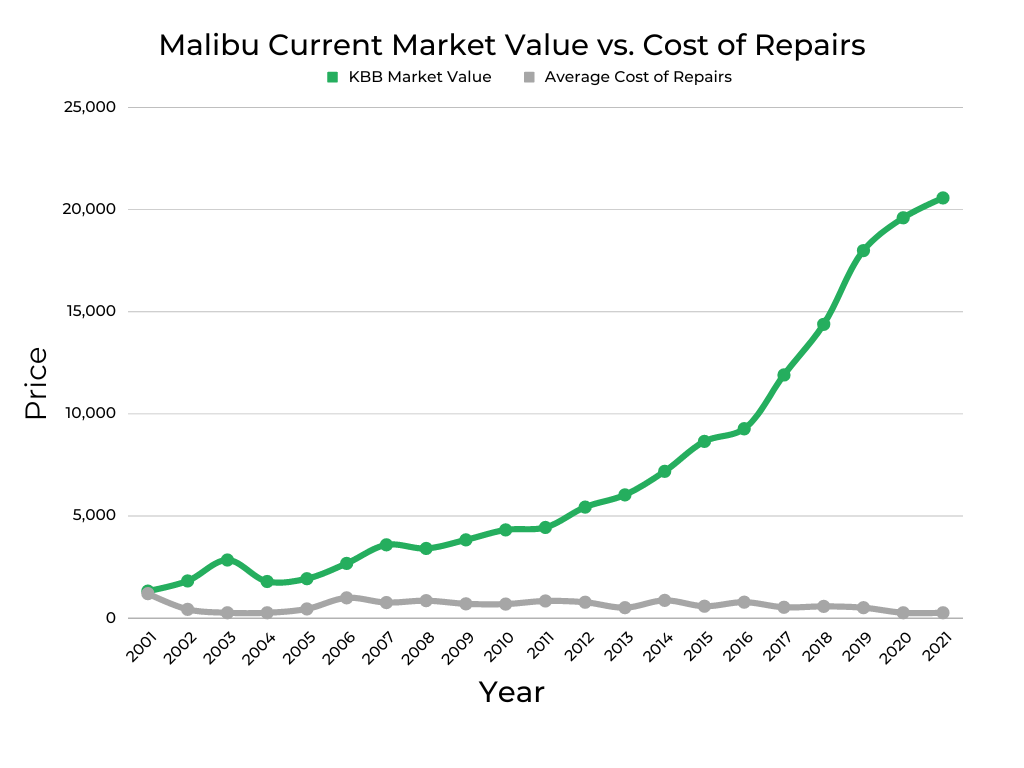
This chart plots current Malibu market values from KBB against annual maintenance costs per owner surveys. It’s a valuable set of data points in defining why some model years are best avoided. For example, the market value drops significantly between 2003 and 2004 when that number normally goes up for newer vehicles. It’s one reason the 2004 Malibu lands on our list of worst model years.
If you’d like to learn about this vehicle’s past depreciation rate & our projected depreciation rate based on that, check out: Chevrolet Malibu | Depreciation Rate & Curve Graphed.
When shopping for a used Chevrolet Malibu, it’s important to keep in mind that not all vehicles are cared for equally. To protect yourself from lemons, take along a FIXD Sensor on your test drive. FIXD connects to a free app on your smartphone to tell you more about the vehicle you’re checking out, including check engine lights and other hidden issues that the owner or dealership may be attempting to hide. Click here to learn more and get FIXD for only $19.99 (regular price $59)!
Important Features Timeline

1997: New fifth-gen Malibu returns after a 14-year hiatus
1998: Second-gen airbags debut, sunroof added to options list
1999 : Medium Bronzemist Metallic added to paint palette
2000: 2.4L inline-4 dropped, 3.1L V6 output increased to 170 hp
2001: Front seatback pockets added to LS trim
2002: Floor mats made standard, three new paint colors added
2003: Anti-lock brakes now optional on base Malibus
2004: Sixth-gen Malibu arrives with Maxx wagon body style
2005: Front side-impact airbags made optional
2006: SS model debuts with 240-horse V6
2007: Variable valve timing added to 3.5L V6
2008: All-new seventh-gen Malibu arrives
2009: Bluetooth connectivity becomes optional
2010: 6-speed automatic fitted to most models
2011: 4-speed automatic dropped from lineup
2012: No major changes this year
2013: Eighth-gen Malibu debuts with new engines
2014: Stop-start added to 2.5L motor
2015: Wi-Fi hotspot now lineup standard
2016: Ninth-gen Malibu arrives with first full hybrid model
2017: 9-speed automatic arrives on Premier trim
2018: L, LS, and LT models receive larger fuel tank
2019: Extensive mid-cycle refresh brings a CVT
2020: Hybrid model discontinued
2021 – Wireless smartphone mirroring added
2022 – Base L trim discontinued
The Best Years of the Chevrolet Malibu
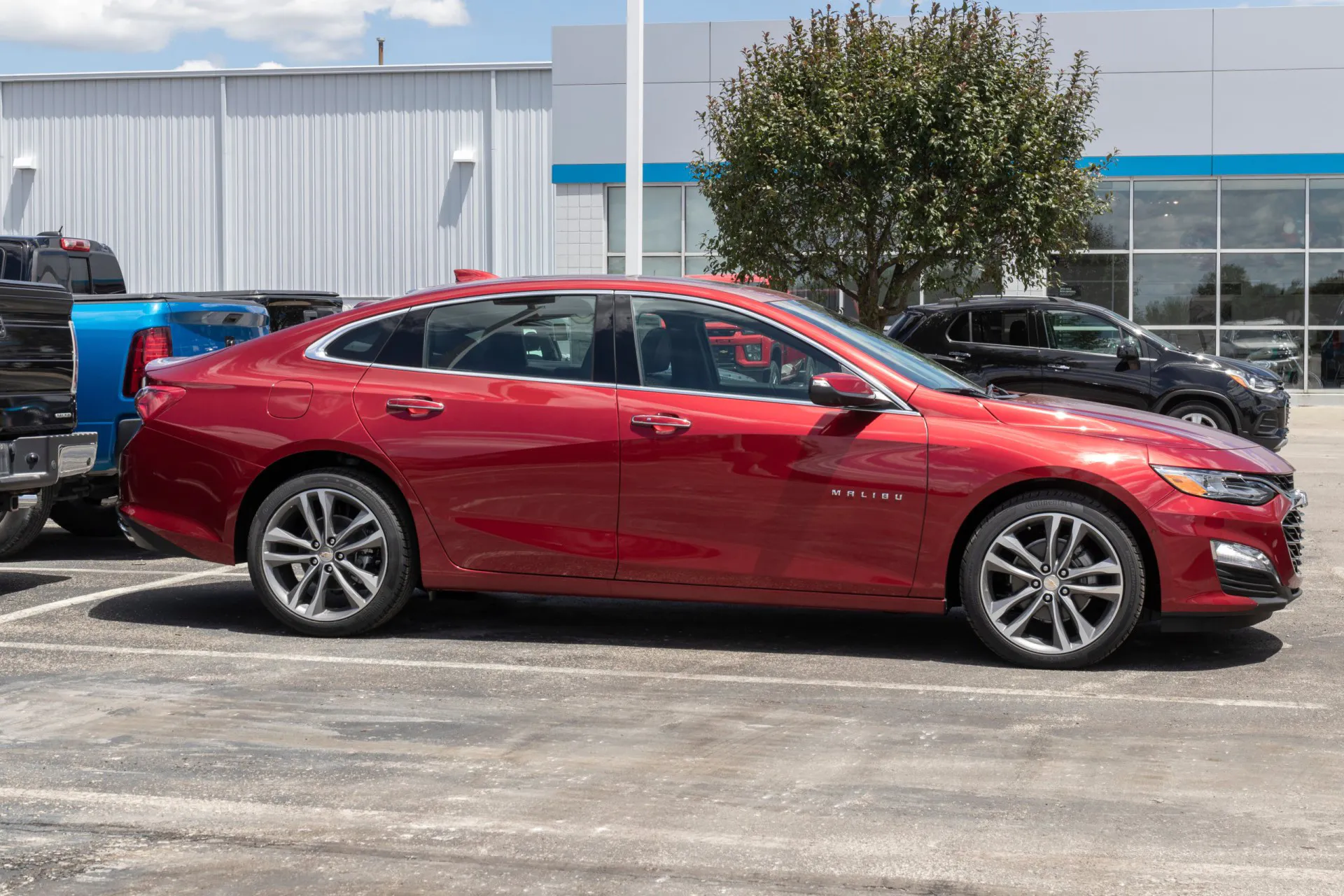
Taking into account FIXD and owner-reported reliability, government safety scores, fuel efficiency, and Malibu owner survey responses, we’ve come up with this list of the best Chevrolet Malibus. Pertinent recall information and notes about common DTCs are included as well.
2021 Chevrolet Malibu
FIXD App Engine Reliability: 10/10
Owner-Reported Reliability: 10/10
KBB Value: $20,573
Fuel Economy: 29 mpg
Annual Maintenance/Repair: $250
Safety Rating: 4.2/5
As the newest model year on our list, it’s not overly surprising the 2021 Malibu earns “best of the best” honors. This is helped by perfect reliability scores – in both categories – representing improvements over the prior year. Other highlights include very low annual maintenance costs of $250, zero days in the shop per owner survey, and some of the best fuel efficiency of all Malibus.
The 2021 Malibu is two years beyond an extensive refresh that added more advanced safety nets, a larger infotainment screen, and amenities like heated rear seats. This may help explain why 57% of owners report using the Malibu as a family vehicle this year – it touches on a lot of important areas for family-minded buyers.
Deep into the ninth generation, Chevy has had a chance to hone this model and it shows. Of course, the average mileage of just 37,500 helps, but there are also only two recalls for 2021. Both only affect a few hundred vehicles including one for a rear seat belt spool that is not properly secured.
When CELs rear their illuminated heads, DTC P1101 is one of the most common reasons. It indicates a faulty mass airflow (MAF) sensor that could simply require cleaning for less than $100 or replacement for closer to $300. DTC P0113 is another one to watch out for. It has to do with the intake air temperature sensor, an issue that also tends to be light on the wallet with a replacement cost of about $100.
DTC P0700 is a bit more of a headache that does occasionally show up on the 2021 Malibu. This potentially severe issue has to do with the transmission control module and could mean the shift solenoids are defective.
2017-2019 Chevrolet Malibu
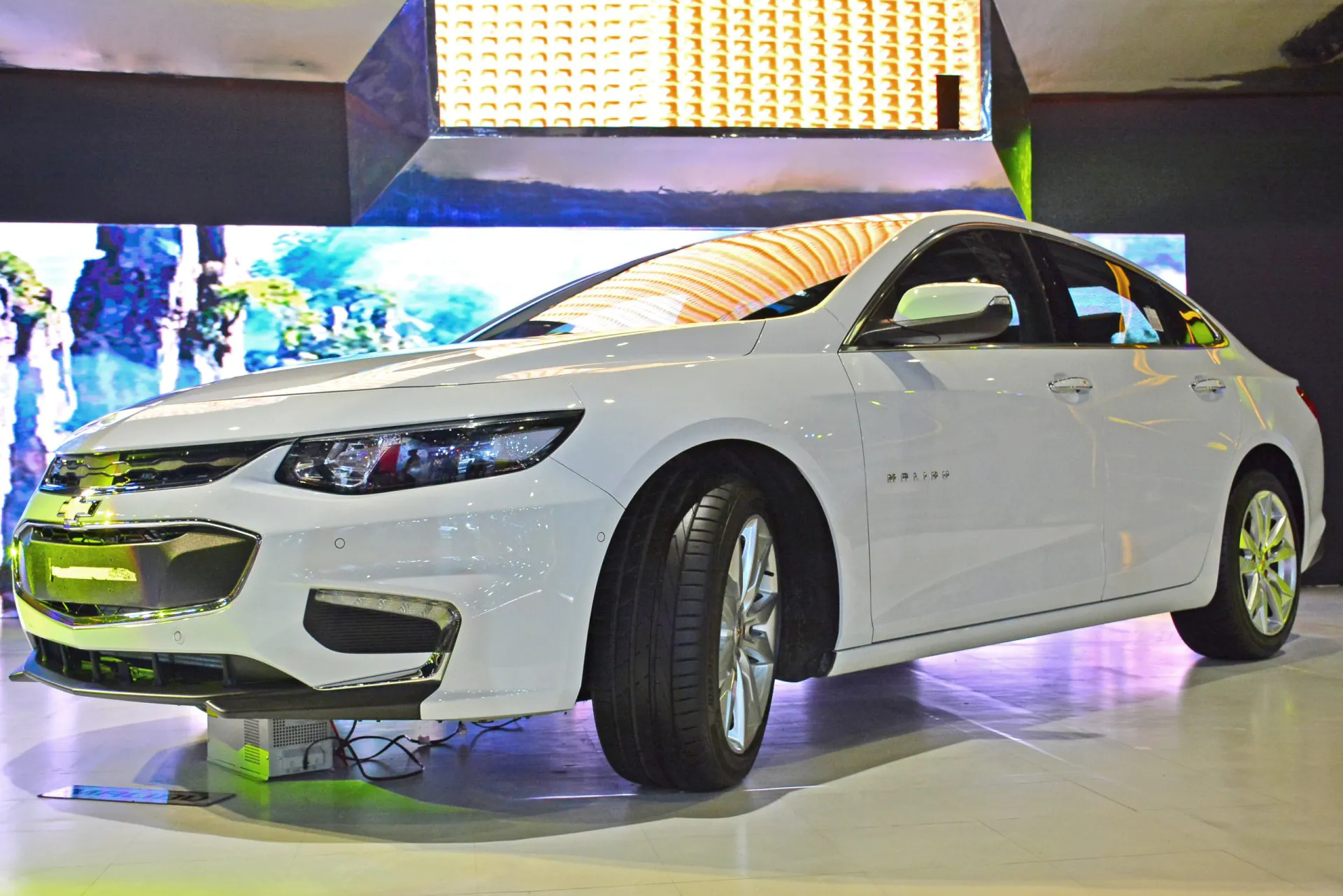
FIXD App Engine Reliability: 8-10/10
Owner-Reported Reliability: 7-10/10
KBB Value: $11,902-$14,384
Fuel Economy: 28-29 mpg
Annual Maintenance/Repair: $500-$563
Safety Rating: 4.2-4.6/5
With a market value under $15,000 and mileage ranging between 70,000 and 100,000, the 2017 to 2019 Chevy Malibu is an excellent value. It helps that both the FIXD and owner-reported reliability scores moved up continually over that 3-year span to 10/10 by 2019.
As well, these model years offer impressive fuel efficiency figures with the hybrid models that are rated for 46 mpg. Gas-powered versions are also helped by the addition of a 9-speed automatic in 2017 and CVT in 2019. Add in the new larger gas tank in 2018 and you can enjoy solid driving range.
Also notable is how market value continually improves while annual repair costs hover well below the average of $629 across all Malibu model years. The fact that 2019 Malibus only have a 50% chance of an expensive repair (versus the average of 84% for the 2001-2021 model years) helps with this.
There are a few CELs to be aware of for these model years. Like the 2021 Malibu, DTC P1101 for a faulty MAF sensor is not unusual and could mean you just need to replace the air filter. If the variable valve timing solenoid starts acting up (DTC P0011), you should stop driving immediately and be prepared for a repair bill of $1,000.
Issues with the catalytic converter also pop up on these 2017-2019 Malibus. Indicated by DTC P0101, replacing the catalytic converter can cost as much as $2,000, however, the issue could also simply be a dirty air filter.
There were few recalls during this span, four in 2017 and just one in 2019 with few vehicles impacted both years.There were six recalls in 2018 and one of them, for an issue with the brake caliper piston coating, affected over 200,000 vehicles. Any Chevrolet dealer should handle a recall repair at no charge for a Malibu up to 15 years old.
2014-2015 Chevrolet Malibu
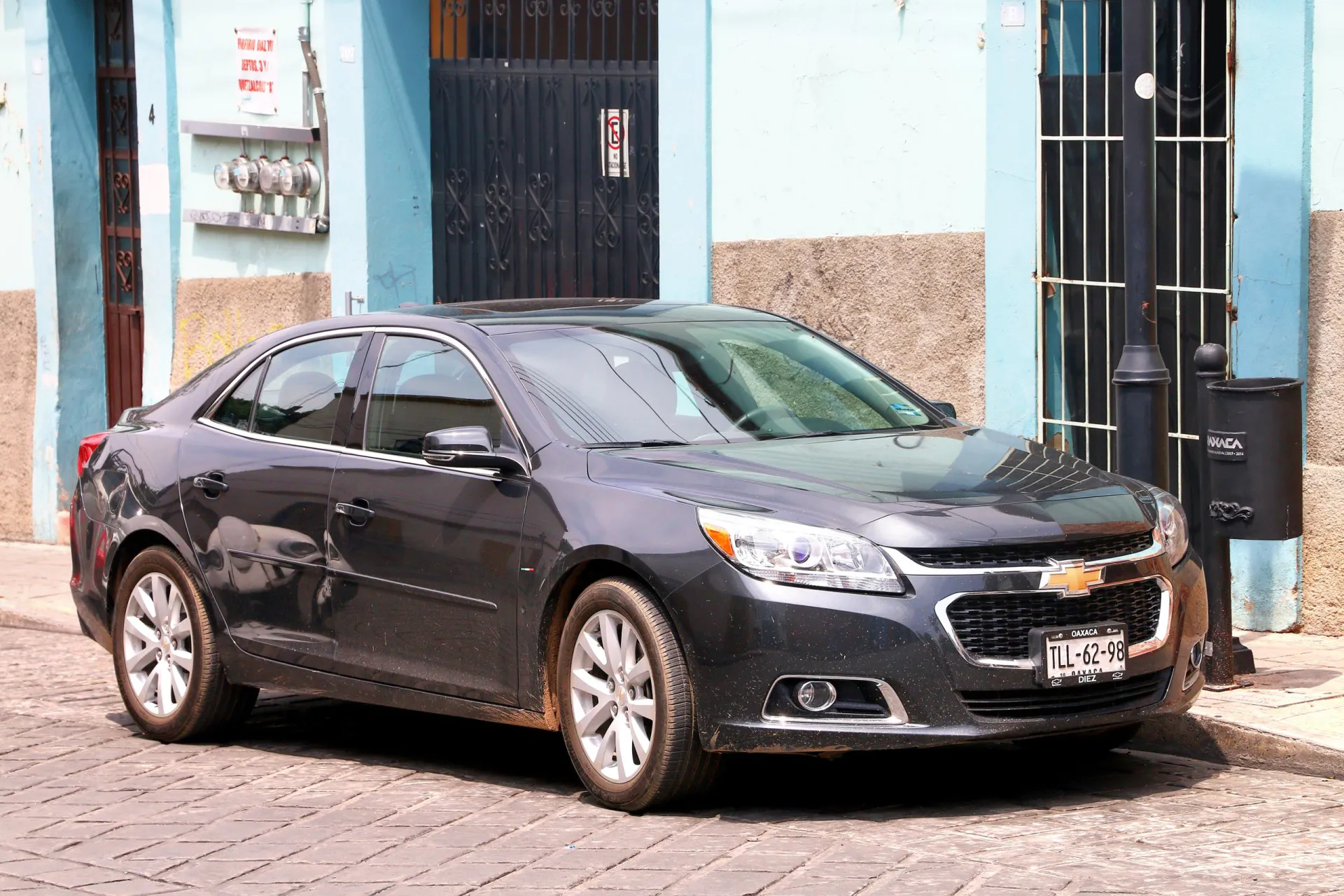
FIXD App Engine Reliability: 7-8/10
Owner-Reported Reliability: 7-8/10
KBB Value: $7,179-$8,646
Fuel Economy: 27 mpg
Annual Maintenance/Repair: $571-857
Safety Rating: 4.6/5
In 2014, Chevy refreshed the Malibu with new front end styling, a new 6-speed automatic transmission, more rear legroom, stop-start technology on the 2.5L motor, and 35 more lb-ft of torque for the turbocharged mill. It was clearly successful as both reliability scores saw increases and market values moved up strongly.
Owners were also happy with the overhaul as 13% approve of the cabin space and 11% report using their Malibu for “Sport/Fast Driving”. That latter figure is significantly higher than the average 2% of owners that use their car this way and correlates with a more potent engine and retuned suspension due to the overhaul.
As well, these model years are solid values with owner-reported odometer readings of between 110,000 and 125,000 miles against KBB values of under $9,000. And the NHTSA safety ratings are above the industry average in both years with scores of 4.6 out of 5.
One caveat is the bump in annual repair costs for 2014 to about $850 and 2 days in the shop per year. That could be related to the relatively pricey – about $1,000 – repair required for the high-pressure fuel pump (DTC P0089). This correlates with a 10% chance of a $500+ repair involving the fuel system for these model years versus an average of 5% across all model years.
Another common DTC is for the intake camshaft position sensor (P0016). If you encounter this code, it’s important to have it looked at right away as it relates to the critical task of keeping the camshaft and crankshaft positioned properly. These model years can also throw DTC P305F, which is related to an NHTSA service bulletin for the battery control module.
There are relatively few safety recalls for the 2015 and 2014 Malibu, though a loss of brake vacuum assist – one of the recalls issued in 2014 – impacted some 140,000 vehicles.
2012-2013 Chevrolet Malibu
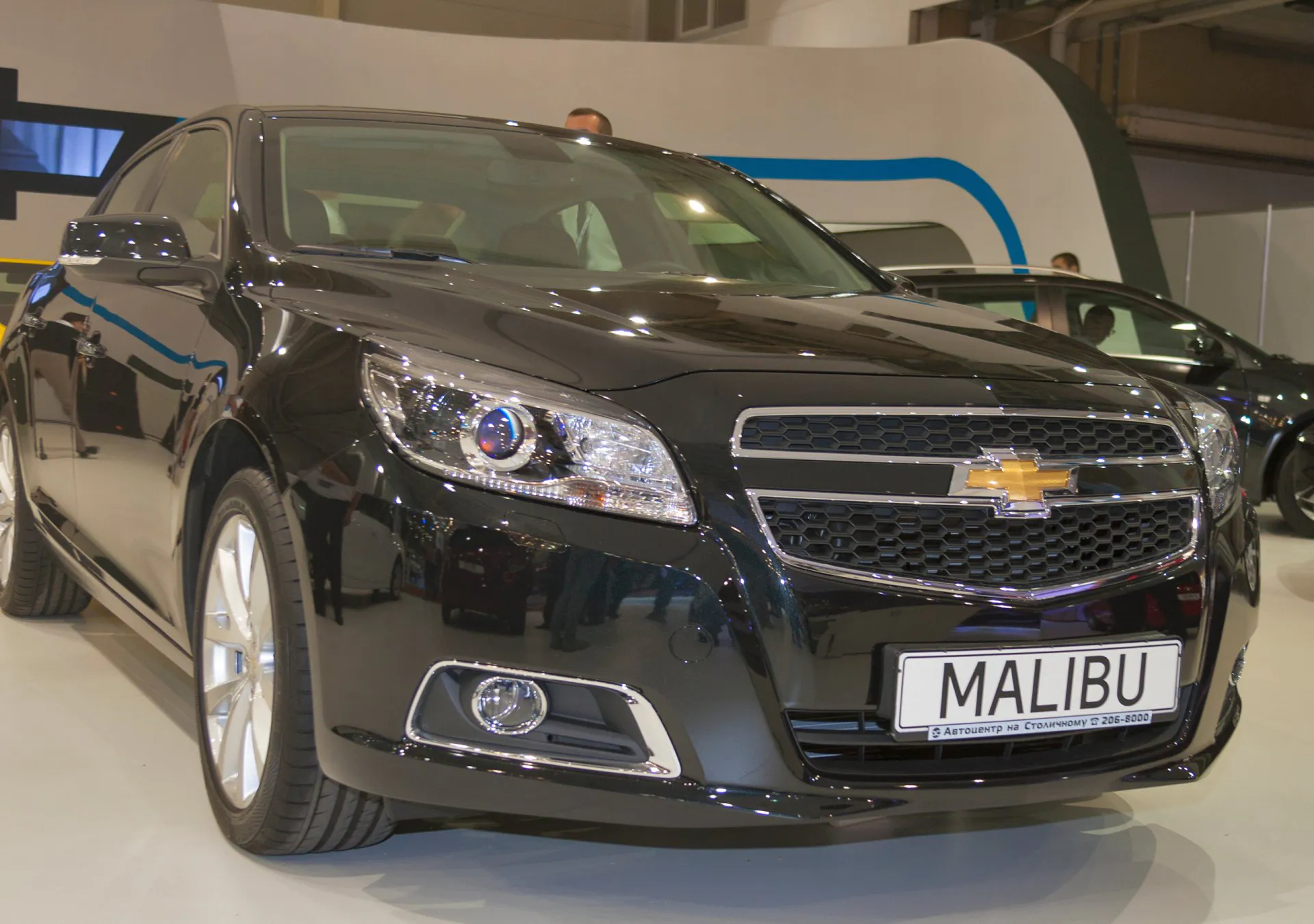
FIXD App Engine Reliability: 6/10
Owner-Reported Reliability: 7/10
KBB Value: $5,427-$6,025
Fuel Economy: 24-26 mpg
Annual Maintenance/Repair: $500-766
Safety Rating: 4.2-4.6/5
These 10-year-old Malibus make our list of best model years because of improvements over prior years in reliability, safety scores, and market values. 2013 marked year one of the eighth generation, an occasion that frequently leads to gremlins. But not only did reliability improve, fuel economy also moved up thanks to more efficient powertrains.
Though these model years typically only show about 135,000 miles, 26% of owners think their cars will run past 200,000 miles. Other highlights include safety scores that move up between 2014 and 2015 and annual upkeep costs that lean towards the low end.
There are some recalls worth being aware of. In 2012, more than two million vehicles were impacted by brake lights that randomly illuminate, and in 2013, there were 11 recalls in all. One of them, affecting about 250,000 cars, had to do with a rear toe link fracturing.
All three of the most common CEL causes are engine-related but range in potential repair cost from the roughly $200 needed to address a faulty oxygen sensor (DTC P2097) to upwards of $1,000 for variable valve timing work on the exhaust side (DTC P0014). Though less severe than P2097, DTC P0010 is also a potentially pricey problem related to the intake camshaft position sensor.
2010-2011 Chevrolet Malibu
FIXD App Engine Reliability: 5/10
Owner-Reported Reliability: 6-7/10
KBB Value: $4,310-$4,430
Fuel Economy: 24 mpg
Annual Maintenance/Repair: $676-828
Safety Rating: 4.2-4.8/5
Between 2010 and 2011, Chevy dropped the long-running 4-speed automatic transmission in favor of a 6-speed unit that had begun to percolate through the lineup a few years earlier. It appears to have been a well-executed transition as the FIXD reliability score jumped two points from 2009 to 2010.
Another benefit is the hybrid model from 2010 that delivers 29 mpg, a 5 mpg bump over the gas-powered average. Safety scores dropped off in 2011 however, the NHTSA introduced a revised and more strenuous testing protocol that year which impacted the overall industry as seen on the safety graph.
In both 2010 and 2011, there were only four recalls but they each impacted nearly half a million vehicles. One from 2010 had to do with a transmission shifter cable possibly detaching and in 2011, an issue came to light involving a cable for anchoring seat belts failing.
Annual repair costs do tick up to just over $800 in 2011, which makes sense when reviewing the most common DTCs that year. P0010 and P0014 are both shared with the 2014-2015 Malibu above and can incur costs of around $1,000 for work related to camshaft solenoids.
Fortunately, the other frequent offender is less costly. DTC P0128 indicates the thermostat is on its way out, but replacement should only be a few hundred dollars. You can learn more about this particular trouble code with our video explaining the P0128 code.
2008 Chevrolet Malibu
FIXD App Engine Reliability: 4/10
Owner-Reported Reliability: 5/10
KBB Value: $3,401
Fuel Economy: 23 mpg
Annual Maintenance/Repair: $844
Safety Rating: 4.8/5
In 2008, the Malibu again bucked the industry norm of a new generation struggling with reliability. This year ushered in the seventh generation with new powertrains, a revised hybrid model, a roomier cabin, and more standard safety systems.
It worked, as the FIXD Reliability score – though relatively low at 4 – jumped up from 1 – the lowest possible score. Owners also reported an increase in reliability and the overall fuel economy of the 2008 Malibu moved up by 2 mpg thanks to more efficient engines and transmissions.
The revised interior was also well received as evidenced by 19% of owners reporting comfortable seats (3% higher than normal) and 19% saying the entertainment system is solid (10% higher than normal). However, the annual maintenance costs did run high in 2008, coming in at about $200 more than the overall average.
A tendency for timing chain problems has something to do with this. As indicated by DTC P0017, timing chain replacement can cost upwards of $1,500. As with the 2010-2011 Malibus, DTC P0128 is a common CEL cause that has to do with the thermostat and DTC P0420 may show up indicating the need for a pricey new catalytic converter.
2006 Chevrolet Malibu
FIXD App Engine Reliability: 4/10
Owner-Reported Reliability: 6/10
KBB Value: $2,668
Fuel Economy: 21 mpg
Annual Maintenance/Repair: $981
Safety Rating: 4.6/5
As with the 2008 Malibu, in 2006 the FIXD Reliability score shot up from a low of just 1 to 4/10 while the owner-reported score stayed relatively strong at 6. Average fuel economy dips here, but that is because the 240-horse Malibu SS arrived in 2006. It only achieves 19 mpg combined, but the fun-to-drive factor certainly moved up.
Considering the average mileage of 159,000 and market value of less than $3,000, these 2006 Malibus could be a strong value. But the relatively high annual repair costs make that value proposition somewhat questionable, which is why this model year straddles the best and worst list.
Most of that potential repair work is due to the brakes as this system has a 35% chance of being the culprit of an expensive repair. Whereas the most common CEL problems tend to be a cheaper fix. Like the 2008, 2010, and 2011 Malibu, a faulty thermostat (DTC P0128) is frequently encountered in the 2006 model. A new one should run you less than $300.
DTC P0463 is another typical problem that indicates the fuel level sending unit is malfunctioning, which runs between $150 and $300 to have repaired. If you see DTC P0455, there is an issue with the evaporative emissions (EVAP) system that may be resolved by simply tightening the gas cap.
As for recalls, there were nine issued in 2006 with the most impactful being related to randomly illuminating brake lights. This potentially accident-causing problem affected more than two million cars. You can use the NHTSA VIN tool to find out if your particular Malibu was impacted.
The Worst Years of the Chevrolet Malibu
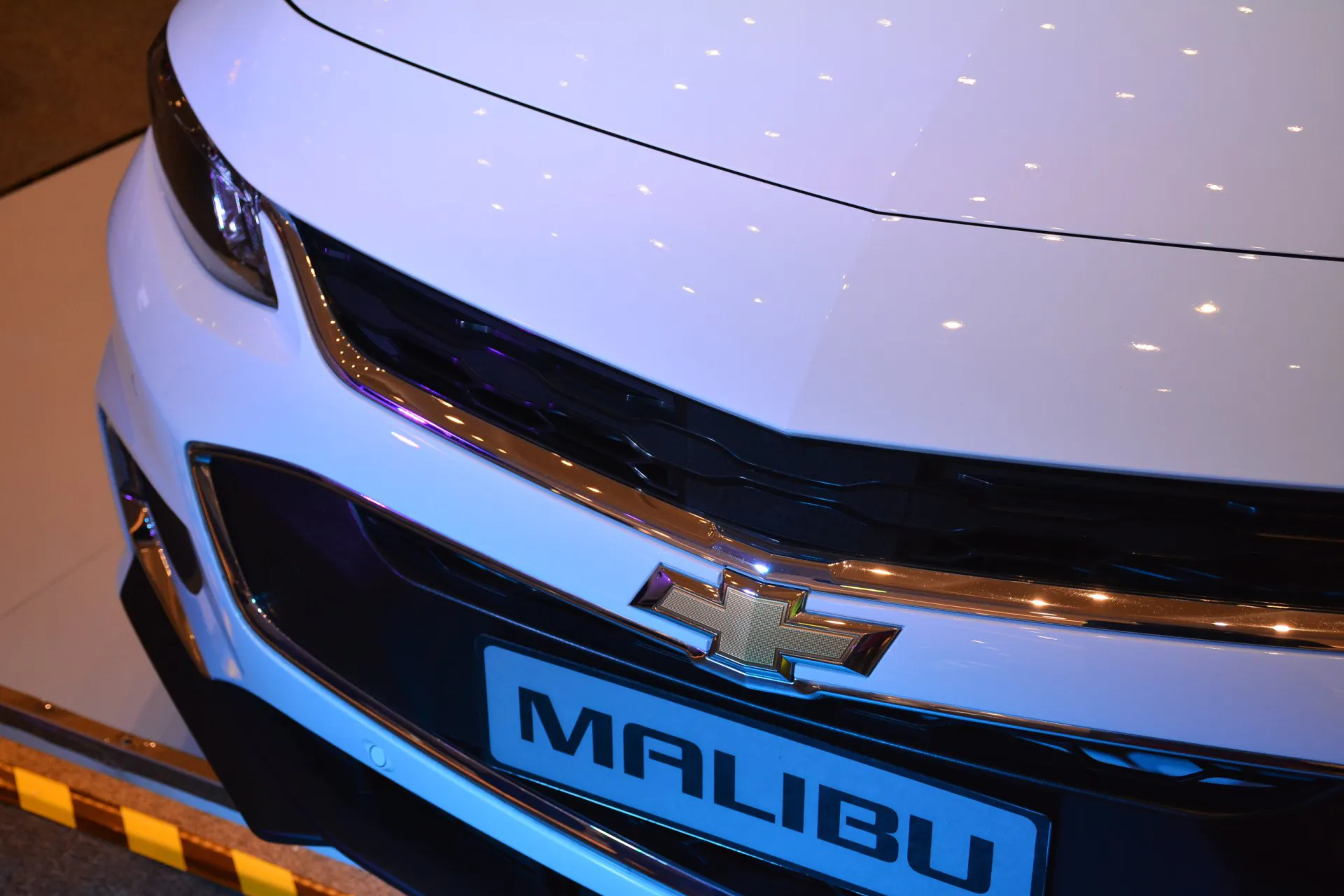
Working with the same information to determine the best Chevrolet Malibus, we’ve compiled the list of model years to avoid. You can expect more issues with reliability, higher maintenance bills, and in some cases lower safety ratings with these poor-performing Malibus.
2007 Chevrolet Malibu
FIXD App Engine Reliability: 1/10
Owner-Reported Reliability: 4/10
KBB Value: $3,579
Fuel Economy: 21 mpg
Annual Maintenance/Repair: $750
Safety Rating: 4.6/5
The 2007 Chevrolet Malibu ranks lowest on our list of worst model years due to sharp drops in reliability for both FIXD – from 4 to the lowest score of 1 – and owner-reported scores – from 6 down to 4. Annual maintenance costs are well above average and there is a 100% chance of an owner experiencing a $500+ repair.
Piling on, the 2007 Malibu spends nearly 2 ½ days per year in the shop, which ties for the longest stretch of all model years even though the typical odometer reading is on the low side at 125,000 miles. Some of this can be chalked up to the addition of variable valve timing to the V6 engine in 2007. Adding complexity to any vehicle is often accompanied by problems.
Those problems can result in expensive repairs like a replacement catalytic converter (DTC P0420) that will run between $1,500 and $2,000. Other common causes of CELs include DTC P0463, which indicates a problem with the fuel level sending unit, and DTC P0455, which has to do with the EVAP system. Fortunately, both of those latter issues can typically be repaired for a few hundred dollars.
There were six NHTSA recalls for the 2007 Malibu with the most prevalent one being the same intermittent brake light issue found on 2006 models. It affected over two million vehicles.
2004-2005 Chevrolet Malibu
FIXD App Engine Reliability: 1/10
Owner-Reported Reliability: 4-7/10
KBB Value: $1,782-$1,919
Fuel Economy: 23-24 mpg
Annual Maintenance/Repair: $250-438
Safety Rating: 4.2-4.6/5
The 2004 and 2005 Malibus squeak past the 2007 model because the owner reliability score showed improvement and annual repair costs are lower. However, none of these three model years is worth considering. The FIXD Reliability score stays flat at the lowest possible score of one for both years, which is to be expected as 2004 marked the first year of the sixth generation.
So, the 10 recalls, four investigations, and 1,690 complaints for the 2004 Malibu are perhaps less surprising even though they are all relatively high. One of those recalls was for an ignition switch that could turn off while driving. It affected close to six million vehicles.
A bright spot is the 23% of owners who feel there is plenty of storage in their Malibu, an all-time high that correlates with the introduction of the Maxx station wagon variant in 2004. But market value goes in the wrong direction and three times the usual number of owners are unhappy with the entertainment system.
These model years also have a good chance of an expensive repair being related to the engine at 23%. The most frequently recorded DTC is P2101, which means there’s a problem with the throttle body. Replacement of which can run up to $500.
Two other DTCs that show up with some frequency include P0128, which means the thermostat is not working properly, and DTC P0463, which indicates a problem with the fuel level sending unit. If your gas gauge readings seem to be inaccurate, this latter issue could be at play.
2001-2003 Chevrolet Malibu
FIXD App Engine Reliability: 1-3/10
Owner-Reported Reliability: 4-6/10
KBB Value: $1,312-$2,836
Fuel Economy: 21 mpg
Annual Maintenance/Repair: $250-$1,188
Safety Rating: 2.8-3.5/5
Capturing the tail end of gen-one production, the 2001-2003 Chevy Malibu shows a slow burn into oblivion on the FIXD Reliability score and a mixed-bag of owner-reported scores that are relatively low nonetheless. Safety scores plummet below three and the 21 mpg fuel efficiency is bottom of the barrel.
Like the 2007 model, these early Malibus spend the most time in the shop each year and the 2001 model is a particularly poor performer. It has the highest annual repair costs over a 20-year span at nearly $1,200. This unreliability may be a factor in why the 2003 model averages just 75,000 miles on the clock – pretty low for a car that’s 20 years old.
Per owner surveys, there is a 40% chance that an expensive repair is related to the fuel system in 2001. Not only is that far higher than any other year, it correlates strongly with the most common CELs during this span.
DTC P0446 means something is awry with the fuel tank pressure sensor, something that costs about $150 to repair. Then there is DTC P0440, which could simply be due to a loose gas cap or a more complex issue with the EVAP system. Another common trouble code is P0404. It could mean it’s time for a new catalytic converter, a job that can run as high as $2,000.
2009 Chevrolet Malibu
FIXD App Engine Reliability: 3/10
Owner-Reported Reliability: 7/10
KBB Value: $3,822
Fuel Economy: 23 mpg
Annual Maintenance/Repair: $688
Safety Rating: 4.8/5
Looking at the reliability chart, we can see a separation of four points between the FIXD and owner scores in 2009 with the owner score increasing by two points into 2009. Digging into the survey data, we find that in 2008, just one owner felt their Malibu could make it across the country without issue versus four that felt it was best suited for around-town driving.
In 2009, those figures effectively swap with three saying their Malibu could go coast-to-coast and zero indicating its fit only for simple Point A to B errands. This is all to illustrate the subjective nature of the owner scores and why they can occasionally vary in dramatic fashion from the FIXD Reliability score.
The objective fact is that in 2009, FIXD sensors recorded nearly 7,500 DTCs versus the average over 20 years of about 4,600. So these model years are prone to reliability trouble and the FIXD score drops to just three. When factored in with the relatively low fuel efficiency, it pushes these Malibus onto our list of years to avoid.
There are six recalls for the 2009 Malibu, though most impact small numbers of vehicles. However, there is one dealing with a faulty shifter cable that could result in the car rolling away while parked. It affected about 276,000 so it’s worth plugging your VIN into this NHTSA tool if you have – or are planning to buy – a 2009 Malibu.
As for typical causes of CELs for this model year, look out for P0700. It is a potentially severe issue related to the transmission control system that could require expert-level repair. DTC P0128 is another frequent offender, but it likely won’t set you back more than $60. It has to do with the coolant temperature sensor, something we explain in more detail here.
DTC P0420 is also typically seen on the 2009 Malibu – along with several other model years – which means the catalytic converter needs to be looked at. You can learn more about what this entails here but it may end up being a pricey day at the shop.
2016 Chevrolet Malibu

FIXD App Engine Reliability: 7/10
Owner-Reported Reliability: 7/10
KBB Value: $9,266
Fuel Economy: 28 mpg
Annual Maintenance/Repair: $769
Safety Rating: 4.6/5
Kicking off the ninth generation, the 2016 Malibu brought with it a new 1.5L turbocharged four-cylinder and a new hybrid model with a revised powertrain. This was accompanied by teething problems, which is not unusual under these circumstances.
As a result, both the FIXD and owner reliability scores dropped a point versus the prior year and the recall count was relatively high with 10 issued. Fortunately, most of the recalls affected only a few hundred vehicles each, but it’s always worth checking to see if your vehicle has any open recalls.
Bright points include strong fuel economy and mileage that averages 100,000 against a market value of less than $10,000. But annual maintenance costs are above average and the braking system was notably problem-prone in 2016 with a 19% chance of being the reason behind an expensive repair.
That aligns with DTC P0556, which showed up nearly 200 times in 2009. That is a five-fold increase over how many times this code appeared in 2017 and far higher than any other model year. It has to do with the brake booster pressure sensor circuit and could mean a new valve is needed.
DTC P1101 is another one to be on the lookout for. It could be a dirty air filter or mean the MAF sensor is due for replacement. If you see DTC P2097, a common one in 2016, you likely need a new oxygen sensor, work that will set you back between $150 and $300.
2020 Chevrolet Malibu
FIXD App Engine Reliability: 8/10
Owner-Reported Reliability: 9/10
KBB Value: $19,600
Fuel Economy: 29 mpg
Annual Maintenance/Repair: $250
Safety Rating: 4.2/5
The 2020 Malibu has the dubious distinction as “best of the worst” model years. Annual repair costs are quite low and fuel efficiency is solid but the FIXD Reliability score dropped by two points, the owner score dropped by one, and the safety score is well under the industry average. It’s an OK model year but we can’t recommend it.
In good news, the addition of wireless Apple CarPlay and Android Auto this year moved the needle significantly on how well owners liked the entertainment system – 21% this year versus an overall average of just 9%. As well, there is only one recall for 2020 that affects just 400 vehicles. It is related to a seat belt spool not being properly secured.
But repairs can be costly, especially if it’s for DTC P0700. This code means there is an issue with the transmission and that could lead to a big-ticket fix. Other common DTCs include P1101, which indicates a faulty MAF sensor, and DTC P0300. P0300 indicates a misfire has been detected and often means it’s time for new spark plugs.
FAQs
What years of the Chevrolet Malibu have engine and/or transmission problems?
The 2009 Chevy Malibu is one to watch out for in the powertrain department. DTC P0700, which indicates a transmission issue, appeared 268 times in 2009 – the highest number over a 20-year span. And when it comes to an expensive repair ($500 or more), there is a 33% chance it involves the engine on a 2009 Malibu – more than double the overall average for this metric.
What is considered high mileage for a Chevrolet Malibu?
200,000 miles is clearly a big number for any Chevy Malibu as only one model year – 2002 – goes beyond that by averaging 225,000 miles. Realistically,140,000 to 150,000 miles is more indicative of a high-mileage example as seven model years land in this range.
Do any hybrid years have problems?
The hybrid Malibu was produced in fits and starts over three generations starting in 2008 and ending in 2019 with gap years in between. Though none of them have hybrid-specific issues, the first two hybrid variants running from 2008 to 2010 and 2013 to 2015 are not worth considering versus the most recent Malibu hybrid that ran from 2016 to 2019.
Unlike the early “mild” hybrids, this final variant was a “full” hybrid which, without going deep technically, means owners enjoy a serious improvement in fuel efficiency. The 2008 Malibu hybrid only earned four more mpg, on average, versus its gas-powered counterpart. The more recent hybrid increased that gap to 18 mpg.
What other vehicles should I consider?
Though the mid-size sedan segment is rapidly shrinking, there are still strong options for new vehicles and even more if you go back a few years into the used market. The Toyota Camry and Honda Accord are still being sold in both gas- and hybrid-powered models. Ford’s Fusion is no longer in production but used models are also available in standard or hybrid form. The long-running Nissan Altima is another strong contender in this segment.
What owners of the Chevrolet Malibu like to use their car for:
| Frequent Use Categories: | How Useful? (Out of 5 Stars) |
| Family Vehicle | ***** |
| Lots of Driving (travel/long commute) | ***** |
| Hauling/Towing | * |
| Office on Wheels | * |
| Sport/Fast Driving | * |
| Luxurious Driving | * |
| Outdoor/Off-Road | * |
A Note About Data and Information Sources
This article has many details about Chevrolet Malibu reliability; here’s what we used for our assumptions and recommendations.
- FIXD Reliability Score & Data: Engine reliability information is captured via the FIXD App.
The FIXD Reliability Score is calculated using the number of DTCs per year, weighted by mileage. This is then turned into a scale of 1-10 for easy graphing.
This is an objective score.
- Owner Reliability Score & Data: This data is the result of surveying Chevrolet Malibu owners who use FIXD.
The Owner Reliability Score comes straight from owners of the Chevrolet Malibu.
This is a subjective score.
To determine the Owner Reliability Score we ask each car owner:
How reliable would you say your Chevrolet Malibu is?
a. Just point A to point B driving
b. A Daily Commuter
c. Good for a 100 mile road trip
d. Good for a 500 mile road trip
e. I could take a cross-country road trip, no problem
From here we translate their answers into the Owner Reliability Score:
a. = 2
b. = 4
c. = 6
d. = 8
e. = 10
Keep in mind, owners may think their car is more or less reliable than it actually is.
One potential problem is that people often buy the same make or model they are used to when they go car shopping, just a newer year.
Ford, for instance, has a number of consumer loyalty awards for the Ford F-Series, Ford Mustang, and Ford Expedition.
Car owners may be so loyal to the make or model they currently own that they would have trouble accurately comparing their cars’ reliability to others.
It’s for this reason that we ask car owners a question that is relative to mileage rather than relative to other cars.
Still, be mindful of the accuracy of these Owner Reliability Scores, people’s perceptions and unconscious blindspots can skew data.
We suggest looking at both the FIXD Reliability Score and the Owner Reliability Score for this reason.
- KBB Value: Average private-seller valuations as supplied by Kelley Blue Book (KBB), based on a Chevrolet Malibu with typical mileage for that respective model year.
- Fuel Economy: Mileage-per-gallon estimates according to the EPA MPG on Fueleconomy.gov
- Annual Maintenance/Repair: Upkeep expenses as reported by surveyed Chevrolet Malibu owners
- Safety Rating: Crash test data collected and reported by NHTSA. We average all ratings for each year to come up with a simplified, average safety score. This makes it easier to look at on a graph.
References
- Chevy Malibu model-specific information. Retrieved May 10, 2023, from https://www.edmunds.com/
- Chevy Malibu model-specific recall information. Retrieved May 10, 2023, from https://www.nhtsa.gov/recalls
- Chevy Malibu model-specific information. Retrieved May 10, 2023, from https://www.auto-brochures.com
- Chevy Malibu model-specific information. Retrieved May 10, 2023, from https://media.chevrolet.com/

Niel Stender grew up doing replacement work on his old Cherokee and sweet Mitsubishi Starion, which led to a degree in mechanical engineering and a job at Ford as a vehicle dynamics engineer. His writing infuses that automotive background with sales and marketing experience. Writing about cars for close to a decade now, he enjoys digging into some of the more technical mechanical systems under the hood and throughout a vehicle.

